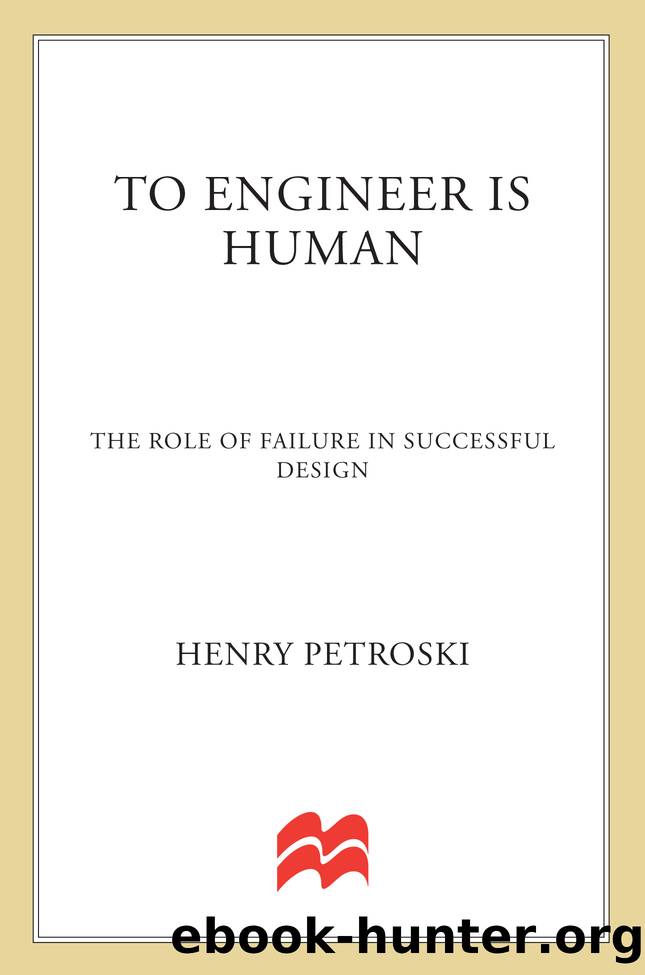To Engineer Is Human_The Role of Failure in Successful Design by Henry Petroski

Author:Henry Petroski [Petroski, Henry]
Language: eng
Format: epub
Tags: Technology & Engineering, General, Architecture, Criticism, Design, History & Criticism
ISBN: 9780679734161
Google: Ua1vDwAAQBAJ
Amazon: 0679734163
Goodreads: 42036593
Publisher: Vintage
Published: 1992-03-30T00:00:00+00:00
But the NYCTA claims
it canât get their Grumman 870âs crosstown.
GRUMMAN
Grummanâs ad may not be grammatically impeccable, but its message clearly suggests that New Yorkâs transit authority acted precipitously in giving up the bus. Whether or not the other transit systems operate routes so full of potholes is not made clear, however.
The companyâs protests notwithstanding, the Grumman Flxible bus will remain a classic engineering case study of design failure, even though it caused no catastrophic accident like the Tacoma Narrows Bridge or any deaths like the Hyatt Regency walkways did. The bus is a forceful example of what can go wrong when too many demandsâfuel efficiency, light weight, accessibility, comfort, maneuverability, and moreârequire radical change, and especially reduction of strength, from what had worked successfully for so long. Who would have thought that latter-twentieth-century engineers could not design a metropolitan bus? It may be argued that New York City dramatized its troubles with the buses and could have lived with buses breaking down, for the threat to life was really quite remote. But one can also imagine life-threatening consequences if a bus were suddenly to drop an axle or have its chassis break in two or have its steering shaft bind or break. The probability of catastrophe is extremely difficult to calculate in a bus that seemed to develop one unexpected problem after another. And projections of maintenance costs would be difficult to make with confidence.
The discovery of cracks in metal can indeed be a perplexing problem, for their origin, growth, and threat can be difficult to assess, especially when there are questions about how the cracked structure was designed, manufactured, and used. Not long ago I had nine stainless steel knives arranged before me on my desk in a formation not unlike that of the Grumman Flxible buses that were parked on the New York City pier. Like the buses, a significant number of the knives had developed cracks, which were clearly visible in three of the nine knives at the base of the blade, near the handle. While the cracked knives seemed to be serviceable, the fissures made the metal look vulnerable and fragile, and I tried to ascertain their cause and possible effect on future use of the knives.
The possibility and consequences of steel letting go are no more difficult to imagine for knives than for buses. I could see myself struggling at dinner one evening to slice a piece of meat when the blade might encounter a bone. The crack would open suddenly and the inertia of the handle I would be holding could drive my fist down onto the edge of the plate. The whole thing could flip off the table, propelling the severed blade end over end through the air, out through my open window, across the driveway, into the open window of my neighbor, through the bars of his bird cage, and through the canaryâs throat. Who knows what else might happen? So while the knives sat arranged on my desk, my family got
Download
This site does not store any files on its server. We only index and link to content provided by other sites. Please contact the content providers to delete copyright contents if any and email us, we'll remove relevant links or contents immediately.
| American National Standards Institute (ANSI) Publications | Architecture |
| History | Measurements |
| Patents & Inventions | Research |
Whiskies Galore by Ian Buxton(41864)
Introduction to Aircraft Design (Cambridge Aerospace Series) by John P. Fielding(33064)
Small Unmanned Fixed-wing Aircraft Design by Andrew J. Keane Andras Sobester James P. Scanlan & András Sóbester & James P. Scanlan(32743)
Craft Beer for the Homebrewer by Michael Agnew(18140)
Turbulence by E. J. Noyes(7934)
The Complete Stick Figure Physics Tutorials by Allen Sarah(7307)
Kaplan MCAT General Chemistry Review by Kaplan(6865)
The Thirst by Nesbo Jo(6825)
Bad Blood by John Carreyrou(6542)
Modelling of Convective Heat and Mass Transfer in Rotating Flows by Igor V. Shevchuk(6391)
Learning SQL by Alan Beaulieu(6208)
Weapons of Math Destruction by Cathy O'Neil(6139)
Man-made Catastrophes and Risk Information Concealment by Dmitry Chernov & Didier Sornette(5920)
Digital Minimalism by Cal Newport;(5661)
Life 3.0: Being Human in the Age of Artificial Intelligence by Tegmark Max(5472)
iGen by Jean M. Twenge(5365)
Secrets of Antigravity Propulsion: Tesla, UFOs, and Classified Aerospace Technology by Ph.D. Paul A. Laviolette(5309)
Design of Trajectory Optimization Approach for Space Maneuver Vehicle Skip Entry Problems by Runqi Chai & Al Savvaris & Antonios Tsourdos & Senchun Chai(5011)
Electronic Devices & Circuits by Jacob Millman & Christos C. Halkias(4906)
